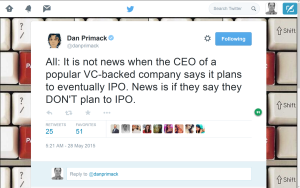Five PR Truths in the Age of Unicorns
Jun 16, 2015 Jason Morris
I’ve seen this movie before. An economic boom helps limited partners become flush with cash to invest with venture capitalists who pump it into twenty-something led start-ups promising to disrupt everything. This too was the storyline when I cracked into technology PR back in 1998.
Back then, it was the Internet that was disrupting things. The ubiquity of Internet connections combined with a computer in every home. Today, it’s mobile and cloud that are disrupting things. The ubiquity of wireless Internet access and cheap web infrastructure combined with a computer in every pocket.
In 1998, there were packs of wild horses—newly minted billion-dollar Internet companies that were running rampant over traditional industry with no signs of being corralled. In truth, it was a few thoroughbreds (Amazon, eBay, Google) and steady mounts (Yahoo!, Red Hat) mixed in among a herd of confused donkeys that would soon run off of a cliff. Today, it is horses with a horn (a.k.a. unicorns) that are high-flying with wings extended.
Will they fall to earth? Are the stars in this sequel Billy Dee Williams or Jar-Jar Binx? I’ll let the “bubble or not a bubble” pundits debate. But there are some undeniable truths about how PR is being impacted in the Age of Unicorns and some of these truths are derivative of the late 1990s. Here are five PR truths in the Age of Unicorns:
1. Reporters are insanely busy - In 1998, many reporters were still on weekly reporting schedules and companies cared about being in print more than online. Journalists had time to do in-depth stories with multiple sources without the distractions of Twitter. Today, reporters post multiple times per day in between moderating panels and live tweeting news. Getting their attention is tough and when you have it, you better not waste it.
2. The threshold for financial news is nuts – twelve months ago, you could easily expect a nice lineup of reporters who wanted to hear about your $5 million in financing. Today? PR people are tweeting that reporters are scoffing at the news value of $50 million in financing. Rumors of an IPO are inconsequential and $500 million in valuation is next to nothing.
Is it tough? Sure. But I think there is a silver lining—too many agencies are proud of stories like, “Cloud Startup Acme Tech gets $50 million from Sequoia.” Funding news is an opportunity to have a more substantive conversation about why you exist. Why would you waste a platform like WSJ, New York Times, TechCrunch or Fortune, to talk about expanding your marketing and sales team? Tell people why they should care about the problem you are solving and why you’re uniquely positioned to solve it. It’s been the same in PR forever—if you tell a good story and people will listen.
3. Media are the story - in the late 1990s, the tech media universe exploded and major changes in editorial teams and the merging of media brands dominated news cycles. Fast forward to today and Twitter blows up when Gigaom folds, Buzzfeed makes six hires or Re/code becomes a sibling to The Verge. This scenario has become even more pronounced as blogs, social media and events have made it much more possible to have a personal “brand” for journalists than ever before. Is it narcissistic? Sure. But if it gets clicks…..
4. PR people are in-demand – When the tech industry booms, so too do PR firms that specialize in technology. We’ve felt it first-hand at InkHouse. We do very little outbound selling or soliciting of clients, and yet, in the eight months since I joined the firm we have consistently had at least twice the number of prospects than we can handle. The nice thing about this PR environment is that our biggest challenge is not growth—its managing growth to make sure existing clients and new clients are well taken care of and that our people don’t get burned out. Anyone looking to engage with a PR firm or hire an in-house comms person knows that it’s a challenge right now. That’s attributed to this crazy growth and it means hiring and retaining the right people is critical.
5. Content is more important than ever – with reporters crunched for time, unicorns dominating headlines and the industry living in a Silicon Valley echo chamber, it is more critical than ever that companies get comfortable with content-based campaigns that mix earned and paid approaches. It’s not about the placing of an occasional byline or posting a weekly blog roundup, but implementing a strategic and systematic content campaign that generates a drumbeat of visibility with strategic audiences and amplifies overall brand awareness. This includes not just textual content, but visual, social and digital content to help earned and paid results.
The Age of Unicorns is an exciting time in the technology industry as we watch devices get smart, online marketplaces explode and industries like transportation, energy and even food, get upended like never before. It’s an exciting time in PR too, but not without its intricacies, growth-related challenges and new approaches which need to be explored and managed in order to stand out from a well-heeled crowd.








